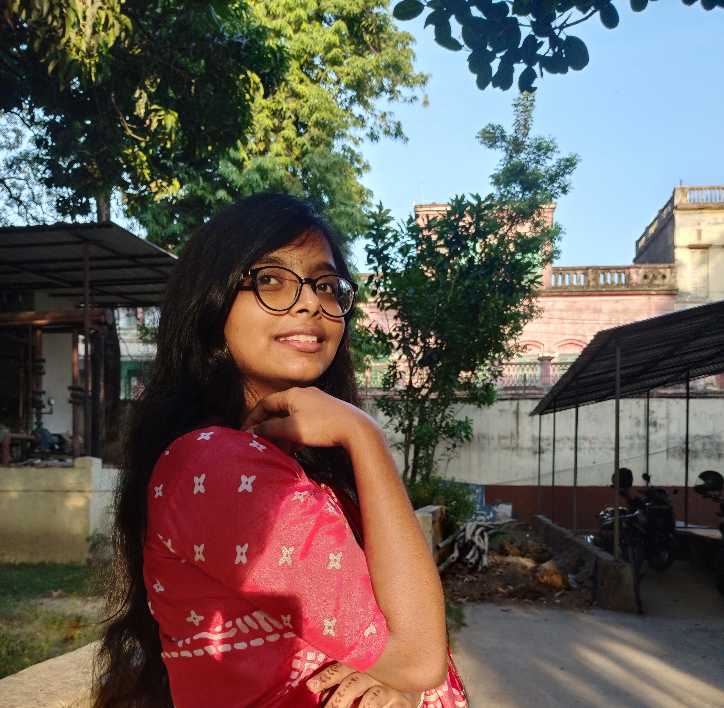Introduction: The Disguised Storytellers of Bengal
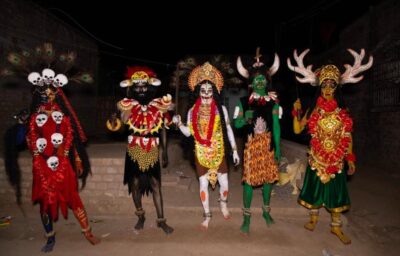
Source: Shubhrarup Bandyopadhyay
In the vibrant tapestry of Bengal’s folk traditions, the Bohurupi stands out as a compelling and visually captivating art form. It is an art that is traced back to the original performance and is filled with a sense of mythology. The term Bohurupi itself means “a person who has many (bahu) forms (rupa)”. A Bohurupi is folk artist who assumes a variety of forms, such as gods, demons, animals, saints, and even through the characters of famous stories such as Laila or Majnu, to narrate stories, entertain, and enliven spiritual reflexivity.
Bohurupi is distinct because it merges performance, costume, make up, and movement, all of which take place in open spaces without a proper stage set-up. The performance takes the form of spiritual symbolism, theatre, performance art, mimetic performance, which often included social commentary. It played a vital role in village life and was once a common feature in rural Bengal. To appreciate its cultural richness one must delve into its roots, evolution, and enduring relevance.
Origins: Born from Myth, Rooted in the Soil
It’s hard to pin down exactly when the first Bohurupi walked into a village, face painted and voice booming. According to some, the idea of Bohurupis emerged from the Ramayana and Mahabharata, where at different time, characters could change their forms. For example, in the Ramayana, the demon Marich transforms himself into a golden deer, exactly what a Bohurupi does.
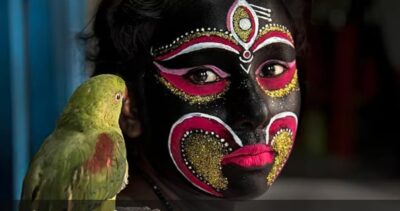
Source: Homegrown.com
Scholars have identified references to wandering mimics in Buddhist Jataka literature dating to as early as the fourth century BCE. Mentions are also found in Charyapada Vajrayana verses from the twelfth and fourteenth centuries CE, as well as in the Mughal historian Abul Fazl’s ‘Ain-i-Akbari’, composed in the sixteenth century. These individuals were not the same as present-day Bohurupis, but may have drawn on a similar performance tradition.
Ujjal Mukhopadhyay, a dramatist and a researcher on Birbhum’s folk culture, says that since the Byadhs, the social group, mostly associated with this art form, were genrally hunters, they already had the idea of dressing up like others as a way of camouflage. This, in a way, may have given birth to this performing art.
Also, following the enactment of forest laws by the British Raj in 1927, the Byadh or Bediya or Bed community gradually sought alternate means of livelihood. According to the community’s oral histories, a man from the Byadh community, working as a guard was inspired by an actor’s performance, and taught the art to other Byadhs. It was then adopted by the community as a source of livelihood.
The magic of the Bohurupi lies in transformation, not just physical, but spiritual. But it wasn’t just theatre. It was a moment of belief. And it came wrapped in some cheap materials like zinc oxide, vaseline, coconut oil, vermillion, ash and Alta (red liquid colour) as well as their props like spear, arrows, bow, masks of gods and goddesses like Kali and ten heads of Ravana as well. This was enough to mesmerize the commoners, to give entertainment in mundane lives, sometimes enough to feed their children in the name of the fierce demons.
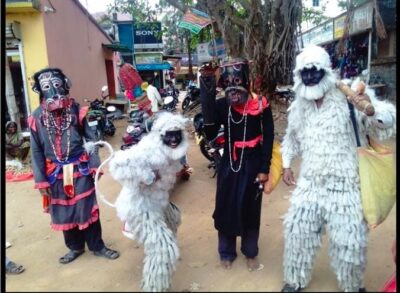
Source: Ethnoflorence
How it Flourished: The Rise of the Living Spectacle
The socio-cultural milieu of pre-modern rural Bengal proved to be fertile breeding grounds for the Bohurupi tradition. With limited options for formal entertainment, villagers depended heavily on seasonal festivals, fairs, and religious festivals for recreational as well as moral education. Within these contexts, Bohurupi became a center of attention.
The Bohurupi would often travel alone or with a small troupe. With no stage, no script, and no lighting, he would rely entirely on makeup, small props, body language and voice to transport his audience.
These performers weren’t famous. They were usually poor. Often landless and nomadic. Villagers would pay him in coins, rice, old clothes, or food and this was their only process to earn their breads. It wasn’t glamorous work, but it was respected.
Some families passed down the tradition for generations. To them, it wasn’t just a performance, rather it was a way of life.
Different Faces of the Bohurupi: Faith and Fun
Though painted through one brush, the faces of Bohurupi can be divided into two distinct types, such as mythological characters and folk heroes and secondly, funny representation of commoners.
4.1 Mythological Characters
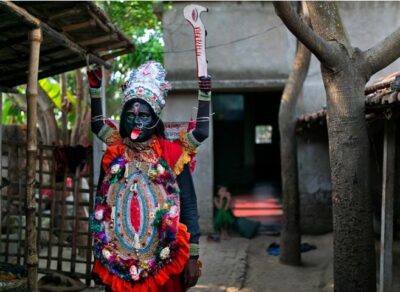
Source: Indrospere
This variation leans heavily on religious iconography. The Bohurupi transforms into deities like Hanuman, Kali, Shiva, or mythological characters like Ravana or Narada. Performances may be silent or include devotional singing and blessings. These acts are typically performed during festivals or on special religious days. The intention is to invoke reverence and connect people to the divine with less performance, more spiritual encounter.
In many rural regions, such performers are welcomed into homes for ritual blessings. They’re fed, given donations and treated with semi-sacred respect, especially if performing as deities like Krishna or Kali.
This variation also includes representation of the characters from folk legends like Chand Sadagar, Anar Kali and most popularly Laila and Majnu.
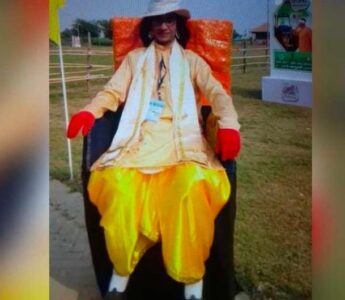
Source: The Telegraph
4.2 The Commoners
Here, the Bohurupi takes on a more dynamic, dramatic role. The focus is on storytelling, satire, and social observation. These artists often mimic village characters, such as drunkards, corrupt officials, greedy moneylenders or enact short narratives that highlight moral lessons. Laughter and reflection go hand in hand.
This form was particularly effective in raising awareness on social issues, including dowry, alcoholism, or caste discrimination.
Thus, because of its humorous and direct nature, the Bohurupi became a vehicle of people’s voice; raw, real, and resonant.
Bohurupi in Popular Culture: Glimpses in the Mirror
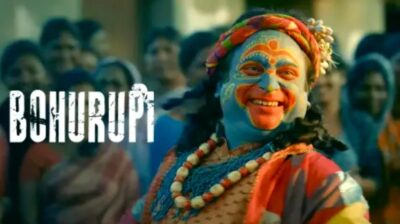
Source: Zee 5
Though not a frequent fixture in mainstream Bengali media, the Bohurupi has left subtle fingerprints across the arts.
Many Bengali people first hear the term of Bohurupi from the autobiographical novel of Sharatchandra Chattopadhyay, ‘Srikanta’ with the mention of Shrinath Bohurupi. Once read, no one can forget the hilarious incident took place just for misunderstanding disguised Srinath, as a real ‘Royal Bengal Tiger’.
More recently, photographers and documentarians have captured these living relics. Rajaditya Banerjee’s documentary, ‘The dying art of Bengal’s Bohurupi’, for instance, focuses on a Bohurupi artist of Tarakeshwar, Ravi Pandit and the challenges faced by the Bohurupi artists.
But the most recent film ‘Bohurupi’, is one of the key factor, which brought the art of Bohurupi into the spotlight. Being one of the most popular films of the year 2024, it helped to popularise the tradition again also growing some kind of respect to the Bohurupi artists, who were neglected and sometimes insulted with the term ‘begger’.
Where Are They Now? A Tradition on the Brink
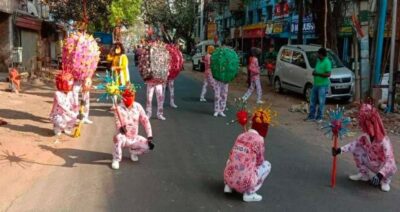
Source: Labhpur PS
Visit many villages today, and you’ll find the Bohurupi replaced by DJs and LED-lit stages. The face paint has dried. The props gather dust. The performers? Many now drive rickshaws, work as peasants or do manual labour to survive.
Now, the tradition is only visible in some parts of Bengal like Tarakeshwar of Hooghly district, Birbhum district and Bishnupur of Bankura district. The village of Bohurupis, Bishoypur of Birbhum, is also in the verge of extinction.
Why the decline?
There’s no single reason. Poverty, lack of institutional support, urban migration, and changing tastes- all play a role. The youth, understandably, often choose stability over a fading art form that offers no regular income or recognition.
However, there is a silver lining. In recent years, several non-profit organizations, cultural anthropologists and government initiatives are trying their best to preserve the art form. During Covid time, government have used many Bohurupi artists to bring awareness among people. Now, they are also invited in some festivals, awareness camps or fairs, arranged by government as artists.
And then there’s social media. Some days ago, Nanichora Das Baul, from the casts of the movie ‘Bohurupi’, have gone viral on platforms like YouTube, Facebook and Instagram, bringing this centuries-old art to digital screens worldwide. Yes, it’s not a tidal wave of change, but it’s a ripple of hope.
Conclusion: Why the Bohurupi Still Matters
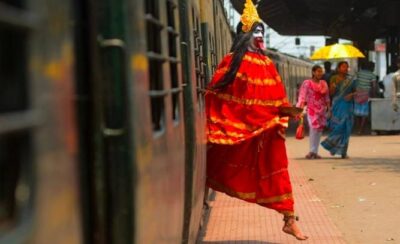
Source: Indrosphere
In a world enamored by identity and visibility, Bohurupi offers something radical, that gives us ability to become many, move in and out of selves, and view the world through different faces.
They remind us that sometimes stories need no screens or stages. That all it takes is a face painted with care, a voice that has been trained with time and most importantly, a heart filled with stories waiting to be shared.
To lose the Bohurupi is to lose a part of Bengal’s soul, its earthy humour, its deep faith, its love for the dramatic and the divine. But if we listen closely, if we look behind the costumes and masks, the Bohurupi still waits, ready to perform, ready to transform.
Let’s not turn away.
Let’s look into those painted eyes and see not just a fading tradition, but the timeless magic of becoming.
REFERENCES:
NEWSPAPER ARTICLE
1. Chaudhuri, Prasun, “Their flashing eyes, their floating hair…”, The Telegraph, January 19, 2025. https://www.telegraphindia.com/amp/life/their-flashing-eyes-their-floating-hair-old-and-new-roles-of-bahurupis-in- bengal/cid/2078335#amp_tf=From%20%251%24s&aoh=17523444300169&referrer =https%3A%2F%2Fwww.google.com
2. Maitra Chakraborty, Barnini, “Changing times, changing forms: How Bishoypur’s Bohurupis are evolving their act”, The Telegraph, November 24, 2021. https://www.telegraphindia.com/my-kolkata/lifestyle/bishoypurs-performance-artists-the-bohurupis-get-support-from-government-and-theatre-groups/cid/1840365
WEB PAGE
1. Ethnoflorence. ‘West Bengal Bohurupi, The Man of Many Faces Tradition”. Last modified October 2, 2022. https://ethnoflorence.wordpress.com/2022/10/08/west-bengal-bohurupi-the-man-with-many-faces-tradition/
2. Indrosphere. Roy Choudhuri, Indrajit. “Bahurupi: The Transformative Performance Art of India”. Last modified July 8, 2022. https://indroyc.com/2022/07/08/bahurupi-the-art-of-disguise-in-indian-folk-culture/
3. Map Academy. ‘Bahurupi’. Last modified April 21, 2022. https://mapacademy.io/article/bahurupi/
4. Sahapedia. Dutta, Arka. “Shapeshifters: The Bediya Bahurupis of Birbhum”. Last accessed July 15, 2025. https://www.sahapedia.org/shapeshifters-bediya-bahurupis-birbhum

